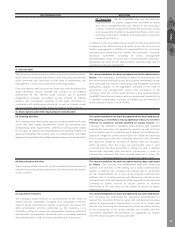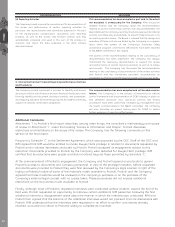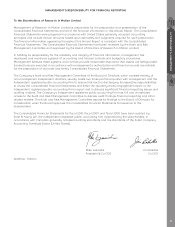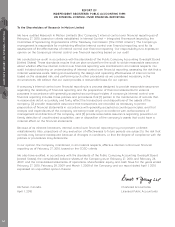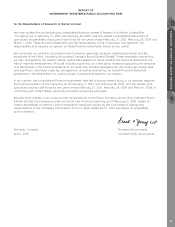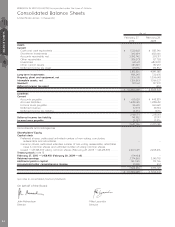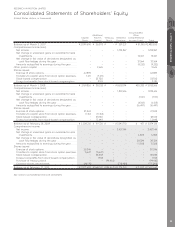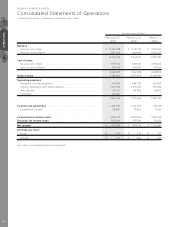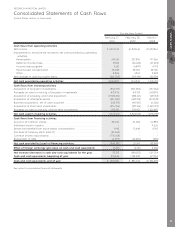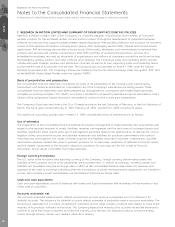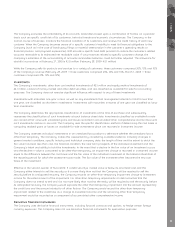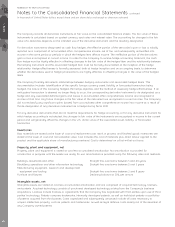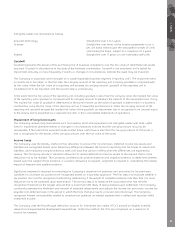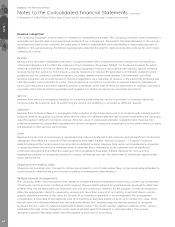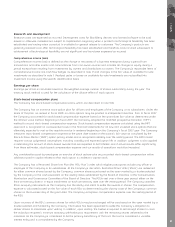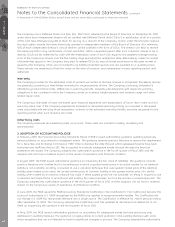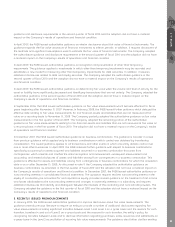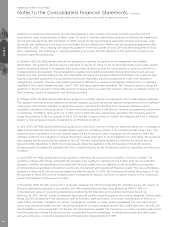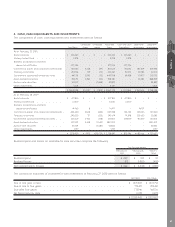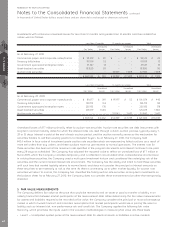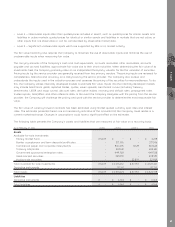Blackberry 2010 Annual Report Download - page 67
Download and view the complete annual report
Please find page 67 of the 2010 Blackberry annual report below. You can navigate through the pages in the report by either clicking on the pages listed below, or by using the keyword search tool below to find specific information within the annual report.
The Company evaluates the collectability of its accounts receivables based upon a combination of factors on a periodic
basis such as specific credit risk of its customers, historical trends and economic circumstances. The Company, in the
normal course of business, monitors the financial condition of its customers and reviews the credit history of each new
customer. When the Company becomes aware of a specific customer’s inability to meet its financial obligations to the
Company (such as in the case of bankruptcy filings or material deterioration in the customer’s operating results or
financial position, and payment experiences), RIM records a specific bad debt provision to reduce the customer’s related
accounts receivable to its estimated net realizable value. If circumstances related to specific customers change, the
Company’s estimates of the recoverability of accounts receivables balances could be further adjusted. The allowance for
doubtful accounts as at February 27, 2010 is $2.0 million (February 28, 2009- $2.1 million).
While the Company sells its products and services to a variety of customers, three customers comprised 20%, 13% and 10%
of the Company’s revenue (February 28, 2009 — three customers comprised 23%, 14% and 10%; March 1, 2008 — three
customers comprised 21%, 15% and 12%).
Investments
The Company’s investments, other than cost method investments of $2.5 million and equity method investments of
$4.1 million, consist of money market and other debt securities, and are classified as available-for-sale for accounting
purposes. The Company does not exercise significant influence with respect to any of these investments.
Investments with maturities one year or less, as well as any investments that management intends to hold for less than
one year, are classified as short-term investments. Investments with maturities in excess of one year are classified as long-
term investments.
The Company determines the appropriate classification of investments at the time of purchase and subsequently
reassesses the classification of such investments at each balance sheet date. Investments classified as available-for-sale
are carried at fair value with unrealized gains and losses recorded in accumulated other comprehensive income (loss) until
such investments mature or are sold. The Company uses the specific identification method of determining the cost basis in
computing realized gains or losses on available-for-sale investments which are recorded in investment income.
The Company assesses individual investments in an unrealized loss position to determine whether the unrealized loss is
other-than-temporary. The Company makes this assessment by considering available evidence, including changes in
general market conditions, specific industry and individual company data, the length of time and the extent to which the
fair value has been less than cost, the financial condition, the near-term prospects of the individual investment and the
Company’s intent and ability to hold the investments. In the event that a decline in the fair value of an investment occurs
and the decline in value is considered to be other-than-temporary, an impairment charge is recorded in investment income
equal to the difference between the cost basis and the fair value of the individual investment at the balance sheet date of
the reporting period for which the assessment was made. The fair value of the investment then becomes the new cost
basis of the investment.
Effective in the second quarter of fiscal 2010, if a debt security’s market value is below its amortized cost and the
Company either intends to sell the security or it is more likely than not that the Company will be required to sell the
security before its anticipated recovery, the Company records an other-than-temporary impairment charge to investment
income for the entire amount of the impairment. For other-than-temporary impairments on debt securities that the
Company does not intend to sell and it is not more likely than not that the entity will be required to sell the security before
its anticipated recovery, the Company would separate the other-than-temporary impairment into the amount representing
the credit loss and the amount related to all other factors. The Company would record the other-than-temporary
impairment related to the credit loss as a charge to investment income and the remaining other-than-temporary
impairment would be recorded as a component of accumulated other comprehensive income.
Derivative financial instruments
The Company uses derivative financial instruments, including forward contracts and options, to hedge certain foreign
currency exposures. The Company does not use derivative financial instruments for speculative purposes.
NOTES 1NOTE 1
59


